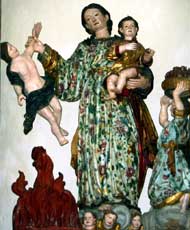The inside
 The inside, in which the themes characteristic of the baroque taste are developed, is divided into three parts: The inside, in which the themes characteristic of the baroque taste are developed, is divided into three parts:
 the lobby with overhanging choristers area, from where one can go to the stairs of the belfry; the lobby with overhanging choristers area, from where one can go to the stairs of the belfry;
 the rectangular nave with a barrel vault, the rectangular nave with a barrel vault,
 the large anomalous and singular presbytery for shape and dimension. the large anomalous and singular presbytery for shape and dimension.
At the presbytery base two couple of columns surmounted by an ornamental big arch, divide the niche of the major altar surmounted in his turn by a baroque decorative structure.
Chapel of Santa Rosalia
On the right side of the nave is the chapel dedicated to Santa Rosalia (the church is also dedicated to the Saint as can be read in the architrave of the large window on the facade). Bronte remained a fiefdom of the Palermo Hospital from 1494 to 1799 and the cult of the Palermo saint, now obsolete and almost completely removed, would seem almost imposed by the three centuries of submission and relationships that the Bronte community was forced to maintain with the Palermo community. In fact, the festival was celebrated with great pomp and public market only until 1822. The Chapel with its rich ornamentation, unique in Bronte, fits into the 17th century baroque trend that is widespread in Eastern Sicily. Here, however, the unknown artist has overcome the expressive limits of decoration, making it become a pure architectural form.
In contrast to the small space (the small chapel measures approximately 6.00 x 3.30 x 3.70 metres), the stuccoes, sized for a larger environment, form an exuberant complex of friezes and frescoes recalling various episodes of life of the Saint. |